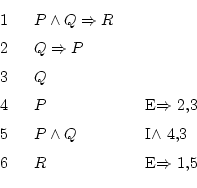Next: 5.3 Empezando a suponer Up: 5 Ejercicios explicados Previous: 5.1 Uno muy sencillo. Contents
Intenta hacer tú solo el
![]() .
Después mira la solución:
.
Después mira la solución:

La única forma que hay de llegar a ![]() es usando la primera fórmula,
es usando la primera fórmula,
![]() , pero sólo la podemos usar cuando
, pero sólo la podemos usar cuando ![]() es cierto, así que vamos a por esto.
es cierto, así que vamos a por esto.
Sabemos que
![]() (línea 2) y que
(línea 2) y que ![]() (línea 3), así
que deducimos que
(línea 3), así
que deducimos que ![]() . Como ahora
. Como ahora ![]() es cierto y
es cierto y ![]() también,
también,
![]() también. Hasta aquí es parecido al ejercicio anterior.
también. Hasta aquí es parecido al ejercicio anterior.
Por último, tenemos que
![]() , y sabemos que
, y sabemos que ![]() ,
así que acabamos diciendo que
,
así que acabamos diciendo que ![]() .
.